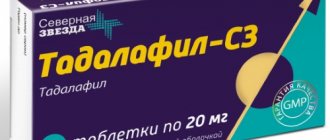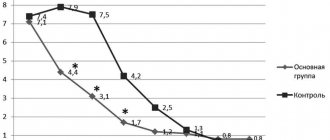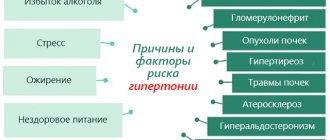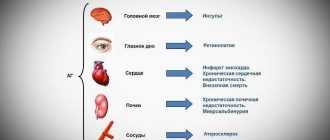ATTENTO film-coated tablets 5mg+20mg No. 28
Combination of amlodipine and olmesartan medoxomil The antihypertensive effect of Attento® may be enhanced when used simultaneously with other antihypertensive drugs (for example, alpha-blockers, diuretics). Olmesartan medoxomil Concomitant use with potassium-sparing diuretics, potassium supplements, table salt substitutes containing potassium, or other drugs that increase the level of potassium in the blood plasma (for example, non-steroidal anti-inflammatory drugs (NSAIDs) (including selective cyclooxygenase-2 inhibitors (COX-2)) is not recommended. 2)), immunosuppressants (for example, cyclosporine or tacrolimus), trimethoprim, angiotensin-converting enzyme (ACE) inhibitors, heparin). If it is necessary to use these drugs simultaneously with olmesartan medoxomil, careful monitoring of the potassium content in the blood plasma is necessary. Data from clinical studies show that dual blockade of the renin-angiotensin-aldosterone system (RAAS) with concomitant use of ACE inhibitors, ARB II or aliskiren is associated with a higher incidence of side effects such as arterial hypotension, hyperkalemia and decreased renal function (including including the development of acute renal failure) than when using only one drug that affects the RAAS. Therefore, the simultaneous use of ACE inhibitors, ARB II or aliskiren is not recommended. The simultaneous use of olmesartan medoxomil and drugs containing aliskiren is contraindicated in patients with diabetes mellitus and renal failure (with a glomerular filtration rate less than 60 ml/min/1.73 m2 body surface area) (see section "Contraindications"). In patients with diabetic nephropathy, ACE inhibitors and ARB II should not be used simultaneously. In cases where the simultaneous use of two drugs acting on the RAAS is necessary, their use should be carried out under the supervision of a physician and accompanied by regular monitoring of renal function, blood pressure and electrolyte levels in the blood plasma. When used simultaneously with antacids (magnesium and aluminum hydroxide), a moderate decrease in the bioavailability of olmesartan medoxomil is observed. With simultaneous use of olmesartan, medoxomil does not have a clinically significant effect on the pharmacokinetics and pharmacodynamics of warfarin or the pharmacokinetics of digoxin. Concomitant use of olmesartan medoxomil with pravastatin in healthy volunteers did not have clinically significant effects on the pharmacokinetics of either drug. There are reports of a reversible increase in the concentration of lithium in the blood plasma and the manifestation of toxicity with the simultaneous use of lithium preparations with ACE inhibitors and ARA II, therefore the use of olmesartan medoxomil in combination with lithium preparations is not recommended. If it is necessary to use appropriate combination therapy, regular monitoring of lithium concentrations in the blood plasma is recommended. No clinically significant inhibitory effect of olmesartan on the isoenzymes CYP1A1/2, CYP2A6, CYP2C8/9, CYP2C19, CYP2D6, CYP2E1 and CYP3A4 of the human cytochrome P450 system was detected in vitro; a minimal or zero inducing effect was noted for rat cytochrome P450, which suggests the absence of clinical significant interactions with the simultaneous use of olmesartan medoxomil and drugs metabolized with the participation of the above isoenzymes of the cytochrome P450 system. With simultaneous use of NSAIDs, including non-selective NSAIDs, selective COX-2 inhibitors, acetylsalicylic acid (at a dose of more than 3 g / day), and ARA II, the risk of developing acute renal failure may increase, therefore monitoring of renal function is recommended, especially at the beginning of use, and Also ensure that the patient regularly takes enough fluids. However, the simultaneous use of NSAIDs and ARA II may lead to a weakening of the antihypertensive effect of ARA II, leading to a partial loss of their therapeutic effectiveness. Colesevelam (bile acid sequestrant) With simultaneous use of colesevelam hydrochloride (bile acid sequestrant) and olmesartan medoxomil, a weakening of the systemic effect of olmesartan medoxomil and a decrease in its Cmax and T1/2 are observed. Taking olmesartan medoxomil at least 4 hours before taking colesevelam hydrochloride reduces this interaction. Olmesartan medoxomil should be taken at least 4 hours before colesevelam hydrochloride. Amlodipine When amlodipine and other antihypertensive drugs are used simultaneously, their antihypertensive effects are additive. When amlodipine is used simultaneously with strong or moderate inhibitors of the CYP3A4 isoenzyme (protease inhibitors, azole antifungals, macrolides such as erythromycin or clarithromycin, verapamil or diltiazem), a significant increase in the concentration of amlodipine in the blood plasma is possible. Clinical manifestations of this interaction may be more pronounced in elderly patients, which may require additional monitoring of the patient's condition and dose adjustment. There are no data on the effect of inducers of the CYP3A4 isoenzyme on the pharmacokinetics of amlodipine. However, it should be taken into account that when used simultaneously with inducers of the CYP3A4 isoenzyme (such as rifampicin, St. John's wort), a decrease in the concentration of amlodipine in the blood plasma is possible. Amlodipine should be used concomitantly with inducers of the CYP3A4 isoenzyme with caution. In animal studies, after taking BMCC (verapamil) and intravenous administration of dantrolene (a drug for the treatment of malignant hyperthermia), cases of ventricular fibrillation and the development of cardiovascular failure with a fatal outcome were observed against the background of the development of hyperkalemia. Due to the risk of developing hyperkalemia in patients prone to malignant hyperthermia, as well as against the background of the use of dantrolene for malignant hyperthermia, it is recommended to avoid the use of BMCCs such as amlodipine. Despite the fact that when using amlodipine, a negative inotropic effect is usually not observed, some BMCCs may enhance the severity of the negative inotropic effect of antiarrhythmic drugs that cause prolongation of the QT interval (for example, amiodarone, quinidine). A single dose of sildenafil in a dose of 100 mg in patients with essential hypertension does not affect the pharmacokinetic parameters of amlodipine. Single and repeated doses of amlodipine at a dose of 10 mg do not affect the pharmacokinetics of ethanol. Antiviral agents (for example, ritonavir) increase plasma concentrations of BMCC, including amlodipine. Neuroleptics and isoflurane enhance the antihypertensive effect of BMCC dihydropyridine derivatives. Calcium supplements may reduce the effect of BMCC. Cimetidine does not affect the pharmacokinetics of amlodipine. The simultaneous use of aluminum or magnesium-containing antacids does not have a significant effect on the pharmacokinetics of amlodipine. In clinical studies for drug interactions, no effect of amlodipine on the pharmacokinetics of atorvastatin, digoxin, warfarin or cyclosporine was noted. The simultaneous use of amlodipine (10 mg) and simvastatin (80 mg) for a long time led to an increase in the concentration of simvastatin in the blood plasma by 77% compared to taking simvastatin alone. The dose of simvastatin in patients taking amlodipine should not exceed 20 mg per day. The simultaneous use of amlodipine and grapefruit juice is not recommended, because in some patients, it is possible to increase the bioavailability and enhance the antihypertensive effect of amlodipine. With simultaneous use, amlodipine may enhance the toxic effect of tacrolimus or cyclosporine, therefore it is necessary to monitor the concentration of cyclosporine and tacrolimus in the blood plasma and adjust the dose if necessary.
Attento, 5 mg+20 mg, film-coated tablets, 28 pcs.
Combination of amlodipine and olmesartan medoxomil.
The antihypertensive effect of Attento may be enhanced when used simultaneously with other antihypertensive drugs (for example, alpha-blockers, diuretics).
Olmesartan medoxomil. Concomitant use with potassium-sparing diuretics, potassium supplements, table salt substitutes containing potassium, or other drugs that increase the level of potassium in the blood plasma (for example, non-steroidal anti-inflammatory drugs (NSAIDs) (including selective cyclooxygenase-2 (COX-2) inhibitors) is not recommended. , immunosuppressants (for example, cyclosporine or tacrolimus), trimethoprim, angiotensin-converting enzyme (ACE) inhibitors, heparin. If concomitant use of these drugs and olmesartan medoxomil is necessary, careful monitoring of the potassium level in the blood plasma is necessary.
Data from clinical studies show that dual blockade of the renin-angiotensin-aldosterone system (RAAS) with concomitant use of ACE inhibitors, ARB II or aliskiren is associated with a higher incidence of side effects such as arterial hypotension, hyperkalemia and decreased renal function (including including the development of acute renal failure) than when using only one drug that affects the RAAS. Therefore, the simultaneous use of ACE inhibitors, ARB II or aliskiren is not recommended.
The simultaneous use of olmesartan medoxomil and drugs containing aliskiren is contraindicated in patients with diabetes mellitus and renal failure (glomerular filtration rate less than 60 ml/min/1.73 m2 body surface area).
In patients with diabetic nephropathy, ACE inhibitors and ARB II should not be used simultaneously.
In cases where the simultaneous use of two drugs acting on the RAAS is necessary, their use should be carried out under the supervision of a physician and accompanied by regular monitoring of renal function, blood pressure and electrolyte levels in the blood plasma.
When used simultaneously with antacids (magnesium and aluminum hydroxide), a moderate decrease in the bioavailability of olmesartan medoxomil is observed.
With simultaneous use of olmesartan, medoxomil does not have a clinically significant effect on the pharmacokinetics and pharmacodynamics of warfarin or the pharmacokinetics of digoxin.
Concomitant use of olmesartan medoxomil with pravastatin in healthy volunteers did not have clinically significant effects on the pharmacokinetics of either drug.
There are reports of a reversible increase in the concentration of lithium in the blood plasma and the manifestation of toxicity with the simultaneous use of lithium preparations with ACE inhibitors and ARA II, therefore the use of olmesartan medoxomil in combination with lithium preparations is not recommended. If it is necessary to use appropriate combination therapy, regular monitoring of lithium concentrations in the blood plasma is recommended.
No clinically significant inhibitory effect of olmesartan on the isoenzymes CYP1A1/2, CYP2A6, CYP2C8/9, CYP2C19, CYP2D6, CYP2E1 and CYP3A4 of the human cytochrome P450 system was detected in vitro; a minimal or zero inducing effect was noted for rat cytochrome P450, which suggests the absence of clinical significant interactions with the simultaneous use of olmesartan medoxomil and drugs metabolized with the participation of the above isoenzymes of the cytochrome P450 system.
With simultaneous use of NSAIDs, including non-selective NSAIDs, selective COX-2 inhibitors, acetylsalicylic acid (at a dose of more than 3 g / day), and ARA II, the risk of developing acute renal failure may increase, therefore monitoring of renal function is recommended, especially at the beginning of use, and Also ensure that the patient regularly takes enough fluids.
However, the simultaneous use of NSAIDs and ARA II may lead to a weakening of the antihypertensive effect of ARA II, leading to a partial loss of their therapeutic effectiveness.
Colesevelam (bile acid sequestrant). With the simultaneous use of colesevelam hydrochloride (a bile acid sequestrant) and olmesartan medoxomil, a weakening of the systemic effect of olmesartan medoxomil and a decrease in its Cmax and T1/2 are observed. Taking olmesartan medoxomil at least 4 hours before taking colesevelam hydrochloride reduces this interaction. Olmesartan medoxomil should be taken at least 4 hours before colesevelam hydrochloride.
Amlodipine. With the simultaneous use of amlodipine and other antihypertensive drugs, their antihypertensive effects are cumulative. With the simultaneous use of amlodipine with strong or moderate inhibitors of the CYP3A4 isoenzyme (protease inhibitors, azole antifungals, macrolides such as erythromycin or clarithromycin, verapamil or diltiazem), a significant increase in the concentration of amlodipine in the blood plasma is possible . Clinical manifestations of this interaction may be more pronounced in elderly patients, which may require additional monitoring of the patient's condition and dose adjustment.
There are no data on the effect of inducers of the CYP3A4 isoenzyme on the pharmacokinetics of amlodipine. However, it should be taken into account that when used simultaneously with inducers of the CYP3A4 isoenzyme (such as rifampicin, St. John's wort), a decrease in the concentration of amlodipine in the blood plasma is possible. Amlodipine should be used concomitantly with inducers of the CYP3A4 isoenzyme with caution. In animal studies, after taking BMCC (verapamil) and intravenous administration of dantrolene (a drug for the treatment of malignant hyperthermia), cases of ventricular fibrillation and the development of cardiovascular failure with a fatal outcome were observed against the background of the development of hyperkalemia.
Due to the risk of developing hyperkalemia in patients prone to malignant hyperthermia, as well as against the background of the use of dantrolene for malignant hyperthermia, it is recommended to avoid the use of BMCCs such as amlodipine. Despite the fact that when using amlodipine, a negative inotropic effect is usually not observed, some BMCCs may enhance the severity of the negative inotropic effect of antiarrhythmic drugs that cause prolongation of the QT interval (for example, amiodarone, quinidine).
A single dose of sildenafil in a dose of 100 mg in patients with essential hypertension does not affect the pharmacokinetic parameters of amlodipine.
Single and repeated doses of amlodipine at a dose of 10 mg do not affect the pharmacokinetics of ethanol.
Antiviral agents (for example, ritonavir) increase plasma concentrations of BMCC, including amlodipine.
Neuroleptics and isoflurane enhance the antihypertensive effect of BMCC dihydropyridine derivatives.
Calcium supplements may reduce the effect of BMCC.
Cimetidine does not affect the pharmacokinetics of amlodipine.
The simultaneous use of aluminum or magnesium-containing antacids does not have a significant effect on the pharmacokinetics of amlodipine.
In clinical studies for drug interactions, no effect of amlodipine on the pharmacokinetics of atorvastatin, digoxin, warfarin or cyclosporine was observed.
The simultaneous use of amlodipine (10 mg) and simvastatin (80 mg) for a long time led to an increase in the concentration of simvastatin in the blood plasma by 77% compared to taking simvastatin alone. The dose of simvastatin in patients taking amlodipine should not exceed 20 mg per day.
The simultaneous use of amlodipine and grapefruit juice is not recommended, because in some patients, it is possible to increase the bioavailability and enhance the antihypertensive effect of amlodipine.
With simultaneous use, amlodipine may enhance the toxic effect of tacrolimus or cyclosporine, so it is necessary to monitor the concentration of cyclosporine and tacrolimus in the blood plasma and adjust the dose if necessary.



